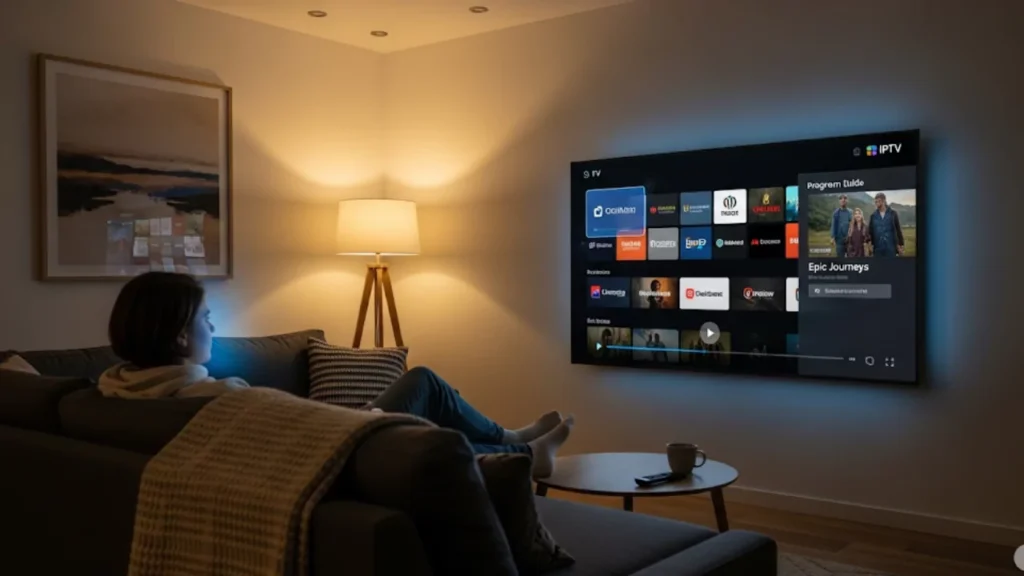IPTV is changing how we watch TV. Now, we can enjoy shows, live channels, and on-demand content in new ways. IPTV is different from cable or satellite. It streams video over your internet. This gives you more flexibility and convenience. Viewers can watch their favorite shows anytime. They can also pause or rewind live TV. This makes for a personalized experience. This technology is becoming popular for people who want to cut the cord. It’s a great option for those switching to modern, internet-based entertainment.
IPTV stands for Internet Protocol Television. It lets you stream live TV, movies, and on-demand content. Instead of using cable or satellite, IPTV relies on an internet connection. It offers three main types: Live TV, Video on Demand (VoD), and Time-Shifted TV (like catch-up or replay). Users can watch on smart TVs, phones, or IPTV boxes. They can also pause or rewind live channels.
Legal IPTV services offer better quality, customizable control, and access on multiple devices. They also often cost less than cable. To set up IPTV, first, ensure you have a stable internet connection. Next, get a compatible device or app. Finally, choose a reliable IPTV provider. This tech is perfect for those who want more freedom and features in their entertainment.
What Is IPTV and How Does It Work?
Definition and Overview
IPTV stands for Internet Protocol Television. It streams TV shows, movies, and live TV through IP networks. This approach differs from the usual broadcasting methods. IPTV is different from cable TV and satellite TV. Cable TV uses coaxial cables, while satellite TV needs a satellite dish. Instead, IPTV sends video content as data packets through your broadband connection.
This streaming service changes video content into digital signals. These signals travel through your high-speed internet connection. You can stream content to your device. This lets you watch programs on smart TVs, IPTV boxes, or streaming devices like Fire TV Stick and Apple TV.
How IPTV Differs from Traditional TV
IPTV services work better than cable or satellite. They send only the content you want instead of showing all channels at once. With a stable internet connection, you can watch what you want. No cable box or satellite dish is needed. You have more control over your viewing experience as a result. IPTV offers features like pausing live channels, catch-up TV, and large content libraries. It also has easy-to-use interfaces and electronic program guides. These qualities make IPTV a modern, convenient choice compared to traditional TV.
What Are the Main IPTV Service Types?
Live Broadcasts
IPTV streams live TV like traditional TV, but it uses your IP network. You can watch live TV channels as they play. This includes news, sports, and entertainment shows. Many streaming services offer hundreds of live channels with crystal-clear streaming quality.
The experience feels familiar – you select a channel and watch real-time content. IPTV providers usually have features like instant replay. You can also record live TV to watch later.
Video on Demand (VoD)
Video on Demand (VOD) services provide large collections of movies and TV shows. You can start, pause, or stop content anytime you want. Netflix and other popular platforms offer endless on-demand options. Many IPTV services mix live TV with a wide range of on-demand content. This gives you the freedom to watch what you want, when you want, all in one place.
Time-shifted Media
Time-shifted TV allows you to watch programs that aired earlier. If you missed your favorite show last night, catch-up TV features let you access it for a limited time. This bridges the gap between live broadcasts and traditional on-demand content.
Time-shifted viewing lets you start a program from the beginning, even if you join late. Some services keep content for days or weeks. This lets you choose when to watch.
Benefits of Using IPTV
Content Control and Flexibility
You have total control over your viewing experience with IPTV. You can make custom viewing schedules, rewind content, and pause live channels. Electronic program guides help you navigate channel selection and discover new programs easily.
- Pause and resume: Stop live TV and pick up where you left off
- Custom playlists: Organize your favorite content in one place
- Multi-room viewing: Watch different programs on various devices simultaneously
- Parental controls: Manage what content family members can access
High-Quality Streaming
Modern IPTV services deliver superior streaming quality compared to traditional cable systems. With adequate bandwidth requirements, you can enjoy 4K resolution and crystal-clear audio. The digital nature of content delivery eliminates signal degradation common with cable TV.
The speed of your broadband connection affects the quality of your streaming. Most providers suggest certain internet speeds for the best performance. This helps reduce buffering and lag during busy viewing times.
Multi-Device Access
IPTV gives you flexibility that traditional TV can’t. You can watch content on many devices.
Here’s a list of devices:
- Smart TVs
- Tablets
- Smartphones
- Android TV boxes
- MAG devices
- Streaming sticks
- Smart home devices
IPTV changes how you enjoy entertainment. It works at home, on your commute, or even at a coffee shop. A single subscription can work for multiple devices, so it’s a smart choice for families.
Internet Protocols and Streaming
IPTV sends video packets over the internet from data centers to your device. Content moves through your HTTP connection as compressed data. Your device then decodes it into a watchable video. Streaming protocols like MPEG-DASH handle the technical aspects automatically.
When you select a channel or program, your device sends a request to the IPTV provider’s servers. The system streams content to your device via your IP network. It only delivers what you are watching.
The Role of IPTV Boxes and Apps
- IPTV boxes are streaming devices that connect to your TV and internet. They offer an easy way to access content.
- Streaming apps on smart TVs and mobile devices remove the need for extra hardware. They run IPTV software right on your current devices.
IPTV boxes often offer better performance and more features than basic smart TV apps. Popular options include Android boxes and specialized devices designed specifically for IPTV services.
Setting Up IPTV Successfully
Choosing a Compatible Service Provider
Look for trustworthy IPTV service providers. They should have valid content licenses and good customer support. Look for providers with good reviews, clear prices, and various channels to meet your viewing needs.
- Content offerings: Ensure they carry your favorite channels and programs
- Streaming platforms compatibility: Verify support for your devices
- Trial period availability: Test the service before committing long-term
- Geographic availability: Confirm service in your area
Required Devices and Equipment
Most modern devices support IPTV without additional equipment. IPTV apps can run directly on computers, tablets, smartphones, and smart TVs. For older TVs, you’ll need a set-top box, streaming stick, or Android TV box.
Your internet connection is crucial – ensure you have sufficient bandwidth for smooth streaming. High-definition content needs at least 5-10 Mbps. For 4K streaming, you should have 25+ Mbps for the best experience.
Installing IPTV Applications
- For official services, you can download the right app from the IPTV provider’s website or the app store on your device.
- Log in to your IPTV subscription service or use M3U URLs to set up the app.
Popular IPTV applications include GSE Smart IPTV and provider-specific streaming apps. Follow the setup instructions carefully to ensure proper configuration and optimal streaming quality.
Are There Legal IPTV Considerations?
Evaluating Service Provider Legitimacy
Pick legal IPTV providers that honor content licenses. They ought to function transparently and offer trustworthy assistance. Legitimate services prioritize high-quality streaming while ensuring your subscription complies with copyright laws. Despite their higher cost, they provide peace of mind. You gain dependable access to content. This helps you steer clear of risks from unlicensed or low-quality providers. These often break copyright laws, which can lead to penalties or loss of service. Investing in a trusted IPTV provider is the safer choice.
Understanding Content Licensing
Licensed IPTV services have agreements to share content. This keeps you safe from legal problems. These providers team up with content creators and broadcasters. They offer real streaming services.
Be cautious of services that seem too good to be true. If a provider has many premium channels for very low prices, they probably don’t have the proper licenses. Stick with established, legitimate providers for peace of mind.
Pro Tips for Better IPTV Experience
To optimize your home network for IPTV, use wired connections whenever you can. Also, make sure your router can support multiple streams at the same time. It is best to place your router in the center of your home. If your house is big, think about switching to a mesh network system.
- Use VPN services like Surfshark VPN for additional privacy and security
- Regular app updates: Keep IPTV applications updated for best performance
- Network monitoring: Check your internet speed regularly during peak hours
- Backup options: Have alternative streaming services for redundancy
Consider the user interface quality when choosing between IPTV providers. A good interface makes it easier to browse content libraries. It also helps manage user profiles, making the experience more enjoyable.
Final Thoughts: Embracing Modern TV
IPTV, or Internet Protocol Television, is the future of home entertainment. It offers flexible and budget-friendly options compared to traditional broadcasting. With better content options and the ability to cut cable costs, IPTV transforms how you watch TV. Begin with a trial from a trusted provider. High-quality streaming is possible if you have a strong internet connection. You’ll also get a personalized viewing experience, often at a lower monthly cost.
Frequently Asked Questions
1. Is IPTV legal in the USA?
Yes, IPTV is legal in the USA if the service provider has the proper licenses for the content they stream.
2. How do I get IPTV on my TV?
You can get IPTV by downloading an app on your smart TV. You can also use a streaming device like Amazon Fire Stick, Roku, or an Android box.
3. What is the difference between paid and free IPTV?
Paid IPTV services provide better quality, more channels, and reliable support. Free services often feature ads, limited access, and frequent outages.
4. What channels do you get with IPTV?
Channels differ by provider. They often feature live sports, international channels, news, movies, and on-demand TV shows.
5. Is IPTV cheaper than cable?
Yes, IPTV is usually cheaper than cable TV. It also offers flexible plans and lower monthly fees.


